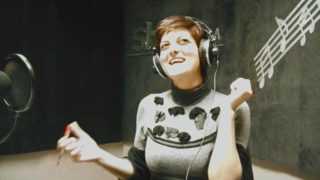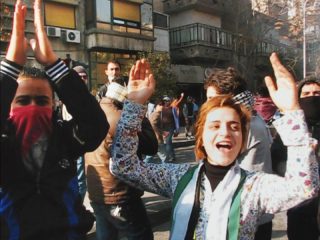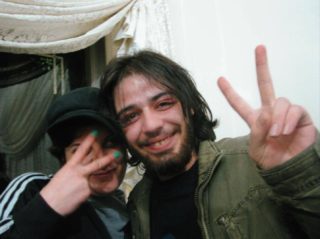By Katie Moritz | Rewire
They’re a group of young friends who drive around listening to the radio, go to the beach and hang out chatting and smoking cigarettes. If you were to come upon them during these leisurely moments, you might think they live completely normal lives.

But something unspeakably huge separates them from your average 20-somethings. Most of their time is spent risking their lives to capture the brutality of the Syrian government on film.
Filmmaker Obaidah Zytoon fought tooth and nail to show Syria and President Bashar al-Assad’s regime through the eyes of the men and women taking to the streets beginning in 2011 to protest its violence. What she saw is preserved in “The War Show,” a stunning documentary from PBS’s “POV.”
Zytoon and her friends—Amal, Lulu, Houssam and others— “united in hatred of subordination and love of uniqueness,” she said in the film. They took on the government with the one thing it seemed to be afraid of, she said.
The camera was their source of fear.”
Arab Spring protests dominated the streets of Syrian cities—you were either joining in or declaring your support of Assad’s regime by opting out, Zytoon said in the film. The government’s No. 1 concern was to stifle any documentation of these protests.

Zytoon said demonstrators with cameras were the first to be taken out by military troops who came to end the protests, sometimes by any means necessary. Zytoon and her friends often talk about hiding the camera so they won’t be spotted. The official Syrian news would report there were no demonstrations going on at all. That the streets were empty.
“The regime fought art with violence but the embers beneath the ashes were never extinguished,” Zytoon said.
Despite the danger in documenting what she sees, Zytoon did it to stunning effect. (The only thing as moving as the raw images she captured is her incredible narration.) When she was on the street with her camera, people who had experienced violence at the hands of the Syrian government clamored to show her their wounds, stripping down in the middle of the street to bare pink, shiny scars and gashes still bloody. Some of these people are small children.

“Show them the bullet in your chest,” one man says to his friend.
Men who had defected from the Syrian army after being asked to attack protestors gave their names and showed their identification cards on camera, declaring their separation from the regime.
“In the street there was an obsession with talking to the camera… as if sharing their story and screening their wounds would cure them of the pain,” Zytoon said. “But it was also a source of danger, so we couldn’t be in one place for more than a few minutes”
Zytoon also visited homes of people searching for loved ones who are missing or healing from serious injuries. One young girl’s throat was slashed open during a shelling. Her father had to stitch her neck back together by hand, capturing the gut-wrenching process on his cellphone. It was a sight that Zytoon said changed her forever.
“Everyone was witnessing their first moments of transformation,” she said of the uprising in the film.
Find out what happens for Zytoon and her friends by watching “The War Show” streaming now!
![]() This article originally appeared on Rewire
This article originally appeared on Rewire
© Twin Cities Public Television - 2017. All rights reserved.
Read Next



